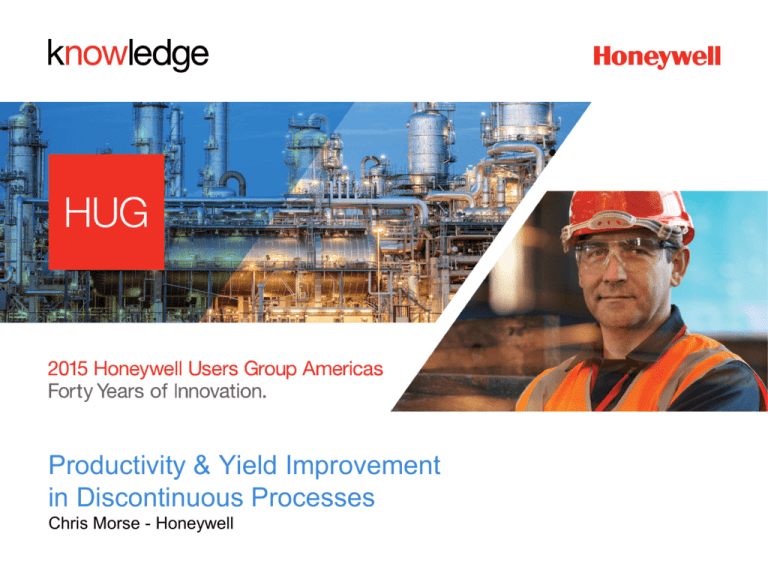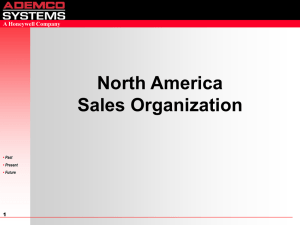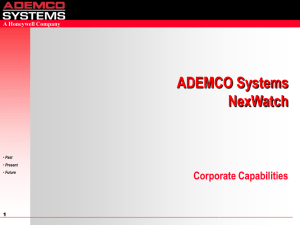
Productivity & Yield Improvement
in Discontinuous Processes
Chris Morse - Honeywell
Raw Material Costs in the Chemicals Industry
• Raw Materials after feedstock
significant cost element for
Chemicals Manufacturers
Typical Financial Basis for
Chemicals Manufacturing
• Optimization of raw material
usage reduces cost of goods
sold
• Automation of Raw Material
additions using Experion
increases efficiency &
productivity
• Techniques shown applicable
to Batch & other
discontinuous processes
2
© 2015 Honeywell International All Rights Reserved
Raw Material Automation - Challenges
• Physical/Chemical material
characteristics vary
• Automation equipment
requires tuning for different
materials
• Manual actions are prone to
error
• Processes/Formulations
change over time
• Certain materials e.g.
catalysts or modifiers are
high cost items
• Raw Material Addition
accuracy has significant QA
impact
3
© 2015 Honeywell International All Rights Reserved
Experion Functions Available to Help
REG
PV
REG
CTL
• Experion Batch Manager
- Scalable for many sequential processes
• Sequential Control Modules
- Raw material additions
• Advanced Sequence Visualization
HPM Tools
- Operator sees status & problems
• Control Modules
- Advanced totalizer & controller facilities
- Auxiliary Calculation
• Procedure Analyst
- Raw Material Usage Report
ExperionTools
4
© 2015 Honeywell International All Rights Reserved
LOG
DIG
COMP
Experion Batch Manager – Cycle Time Reduction
Server Based Mixer Cycle Time
Batch 52 Start
Reactor
Start
Mixer Start
Mix
Sample
6-12 secs
Controller Based Mixer Cycle Time
Discharge
Cycle Time
Reduction
Batch 53 Start
Mixer Start
Material 1
Material 2
5
Reactor Start
Mix
Sample
Discharge
2 secs
© 2015 Honeywell International All Rights Reserved
12 Sec
2 Sec
Server step transition times
Material 2
Controller step transition times
Material 1
Flowmeter Feed Addition
Tank T
Material
Qty
Units
Material A
187.0
Kg
Material B
19.8
Kg
Material C
24.5
Kg
Pre Optimized Flows
Flowrate
Mat A
Mat C
Open
Valve T
Mat B
Setup/Start
Totalizer
Target
Value
Optimization Levers:
Material A
Material B
• Up to 4 pre-targets per
totalize
FT
Material C
• Switch between multiple
totalizers in an SCM
Challenges:
• Material flows differ
affecting cut-off point
• Wide variation in
quantities – same
equipment
• Reduce cycle time of
totalizer min 50 mSec
Open Valve
A/B/C
Pre Target x
Reached
Close Valve
A/B/C
Stop Pump
Autoclave
Flowrate
Mat A
Mat C
Optimized Flows
Close Valve T
Mat B
• Flow measurement
characteristics vary by
material
Continuous Process
6
Start Pump
Pre
Pre
Target 4
Target 2
Pre
Target 3
© 2015 Honeywell International All Rights Reserved
Flow Control Material Addition
Tank T
Material
Qty
Units
Material A
187.0
Kg
Material B
19.8
Kg
Material C
24.5
Kg
Flowrate
Material A
Open
Valve T
Setup/Start
Totalizer
Mode = Auto
SP = Full Flow
Start Pump
Mode = Auto
SP = Trickle Flow
Material A
Material B
FI
Pre
Target 2
Addition challenges:
Pre
Target 1
Optimization Levers:
• Minimise dosing time
with accurate cutoff
• Post target cutoff
content of line can
affect cost/quantity
Mode = Man
OP = 0%
FC
Material C
Slope determined
by OPROC
• Experiment with controller
modes & flow set points for
minimum addition target
deviation
Pre Target 2
Reached
Mode = Auto
SP = Trickle
Pre Target 1
Reached
Mode = Man
OP = 0%
OPCV = 0%
Stop Pump
Autoclave
• Drain line & offset against
line content – may be
equipment specific value
• Maintenance of flow &
cutoff values
• Maintain values as Material
or Equipment value – not
recipe parameters
Continuous Process
7
Mode = Auto
SP= Full
© 2015 Honeywell International All Rights Reserved
Close
Valve T
Mode = Man
OP=100%
Line Drain
Time Complete
Gain in Weight Addition
Calculate
Target
Weight
Tolerance
Un-Discharged
Tank S1
Tare 2
32%
Dry
Matter
Tare 1
Open Vale T1
Challenges:
Start
Pump
Stabilization Time
• Reaching a Stable weight value
• In flight error – varies with time & material
Open
Valve S1
• Residual material on sides of hopper
Target
Reached
W1
• Material lot to lot variation
Close
Valve W1
Wait for
Stabilization
Mixer 2 m3
Intermediate
Storage 5 m3
In Tolerance?
No
Optimization Levers:
Yes
Stop Pump
• Tune out instability
Final Storage
10 m3
Paper Machine
Coating Station
• Compensate for in flight error & material
differences in a calculated target
• Alert Operator to un-discharged material
8
© 2015 Honeywell International All Rights Reserved
Close
Valve S1
Material Quantity Target Tuning
Material A Addition over 5 Batches
Normal Variation with Giveaway
+ve Tolerance
Recipe Target 24.2Kg
-ve Tolerance
B
1
0
1
B
1
0
2
B
1
0
3
B
1
0
4
B
1
0
5
B
1
0
1
B
1
0
2
B
1
0
3
B
1
0
4
In spec but
with material
giveaway &
possible
quality impact
In spec &
consistently
closer to target
for better yield
and quality
Improvement: Maintain Accuracy
for each Batch
+ve Tolerance
Recipe Target 24.2Kg
-ve Tolerance
Applying Material A Bias to next batch over 5 Batches
B
1
0
5
B101
B012
B105
B104
B105
Mean
Bias
over 10
Batches
- 0.2
-0.4
+0.3
-0.2
-0.3
-0.05
Bias correction calculated for each
batch applied to recipe target.
Bias monitoring for Equipment Problem Detection
B101
B012
B105
B104
B105
Mean
Bias
over 10
Batches
+0.2
+0.3
+0.4
+0.5
+0.6
+0.25
Bias calculation tries to correct low
delivery but the root cause is an
equipment problem. Deviation will
eventually occur
9
© 2015 Honeywell International All Rights Reserved
Mean bias over several batches alert
raised if absolute value gets too high
–before spec deviation
Next Batch Compensation & Real Time Release
Mixer Operation
+ve
Tolerance
“Normal”
Target
Value
Material A
Monitoring
-ve
Tolerance
B101
B102
B103
B105
B105
Material B
Mix
In Tolerance?
Positive difference vs target
No
Negative difference vs target
Sample Set
Batch Status
Calculated compensation vs normal target
Assumptions
Yes
End: Release/Quarantine/Reject
End: Release
• Accurate measurements are available
• Batches feed to a downstream process
• Quality values can be calculated or inferred
10
Real Time Release – no quality
deviations detected. Batch moves to
next stage – downstream/packaging
© 2015 Honeywell International All Rights Reserved
Reduced Sampling = Further Cycle Time Reduction
Sampling Once Per Batch
Batch 53 Start
Mixer Start
Material 1
Reactor Start
Mix
Sample
Discharge
Material 2
Reduced Sampling – Deviations Only
Cycle Time
Reduction
Monitoring Phase
• Checks for raw material qty deviations
Batch 53 Start
Mixer Start
Material 1
Reactor Start
Mix
Material 2
Monitoring
Discharge
• Checks other quality variables which
can be automated – e.g. mix time
• Alerts operator to quality problems
• Sets status of batch:
Released/Quarantine/Rejected
• MAY have Supervisor Access
11
© 2015 Honeywell International All Rights Reserved
Procedure Analyst - Materials Usage Reporting
• Material Usage Report
‒ Show target, actual and deviation material amount on a per batch basis
between specified start and end dates
‒ Search for target value deviations
‒ Any material addition SCM can be recorded for reporting
12
© 2015 Honeywell International All Rights Reserved
Raw Materials Optimization – Calculating the Value
• Assumptions:
‒
‒
‒
‒
Production is 340 days/year 24 hours/day
Production Rate 480 Tons/day
Revenue $1500/ton
Raw Material Costs 35% of revenue
• Annual Revenue $244M
• Annual Raw Material Costs $85M
• 1% Reduction in Raw Material savings $850K
13
© 2015 Honeywell International All Rights Reserved
Questions to Ask
• Can our raw material additions be automated?
• Can material addition measurements be
improved?
• How could variations in raw material additions be
smoothed out?
• What data is available for raw material usage?
• Can quality checks be automated?
• Is there a better way of adding some
materials?
14
© 2015 Honeywell International All Rights Reserved
What is the value of 1% Raw Material Savings?
15
© 2015 Honeywell International All Rights Reserved






